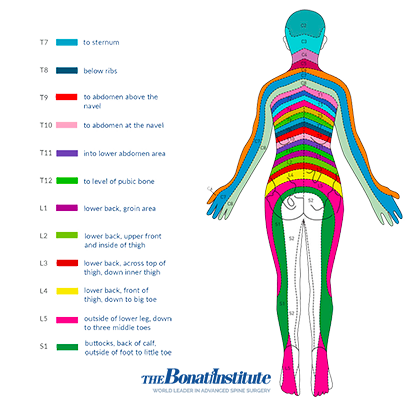Using Brain Waves to Control Prosthetic Devices
Prosthetic Control Technology could one day help people like Marine Mark Ormrod, who lost both legs and one arm in Afghanistan. In 2006, Scientists at the University of Pittsburgh America fitted artificial arms controlled by brain signals to two human patients. The artificial arms have sensors in the breast plate which picks up signals from relocated nerve endings allowing for some control of the prosthetic hand. In previous studies, researchers showed that humans who had been paralyzed for years could learn to control a cursor on a computer screen with their brain waves; and that thoughts could move a mechanical arm, and even a robot on a treadmill.


Locating the Source of Neck Pain
You don’t have to learn to live with pain. If you have been experiencing headaches and/or a burning, numbness or pain radiating along any of these paths for more than 3-4 months, contact your medical practitioner.
Medical Studies
According to a study published in the journal ‘Nature’, recent developments have advanced to connecting prosthetics to the brain allows more precise movements. In laboratory tests, monkeys were able to move an artificial arm by thought and were able to feed themselves with nearly 100 percent accuracy. The monkeys in the experiment had their own arms gently restrained while they were learning to use the prosthetic one. Using the new implants, the monkeys were able to complete simple actions with almost 98 percent accuracy, a respectable improvement on previous studies, where precision averaged around 80 percent.
Macaque Monkeys
The researchers, from the University of Pittsburgh and Carnegie Mellon University, first had the two macaque monkeys use a joystick to get a feel for the prosthetic arm, which had shoulder joints, an elbow, and a grasping claw with two mechanical fingers.. The technological developments involves linking the brain with an artificial limb via implants which send the brain signals along wires the width of a hair. However, the brain emits thousands of signals to control even the simplest of actions, too many to be sent to the prosthetic, so the technology limits the signals to around 100, filling the “gaps” from the ‘missing signals’ with pulses generated by a computer algorithm.
According to Dr Andrew Schwartz, PhD., the research demonstrates a higher level of precision, skill and learning Dr Schwartz is the study leader and a professor of neurobiology at the University Of Pittsburgh School Of Medicine. Although his immediate aim is to make a prosthetic for people who suffer from total paralysis, the ultimate goal is to improve the understanding of brain complexity. The scientists’ hope that their study will eventually offer insights into treatments for diseases ranging from Parkinson’s to Alzheimer’s disease and perhaps even mental illness.
A previous study by Andrew Schwartz, and Arizona State University on monkeys with implanted electrodes in their brains controlling a pong-like computer game, gave the following, “At first they tried to use their arms. But as they realized they could move the balls without moving their arms, they relaxed their arms and continued the game using thought control. As they played, their game skills improved.
Brain Models
“The monkey brain is a model for the human brain.”- Earl Miller, professor at MIT, who cites the importance of research done by Daniel Rizzuto, a postdoctoral neuroscience scholar at the California Institute of Technology.
His theory is that researchers should design electrode pickups to interface with the prefrontal cortex of the brain, which controls spatial processing and is “less hardware specific” than the primary motor cortex. This is advantageous because when a patient has had a spinal injury that causes paralyses, communication to the primary motor cortex may be severed, but the prefrontal cortex will still be functional, which is in charge of movement planning.